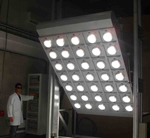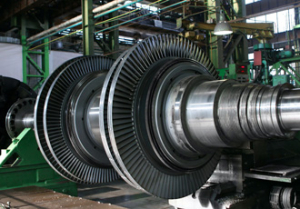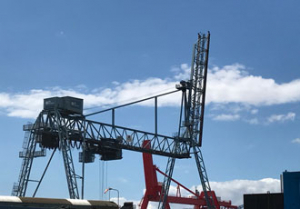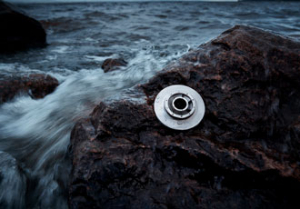A new framework for evaluating sustainable technologies
10th February 2009
Source:
Bosch Rexroth

Standard components from the Rexroth mechanical elements and linear motion ranges have provided a convenient, versatile and cost effective solution to the challenge of mounting and controlling a half-tonne lamp array at the heart of a new state-of-the-art solar simulator facility. This simulator developed by the Centre of Sustainable Technologies (CST) at the University of Ulster will be used to evaluate the performance of photovoltaic (PV) panels, solar water heaters, evacuated glazing and similar products.
The fast growing interest in solar energy sources and environmental protection has created an urgent need for dependable test facilities to assist with and validate the design of new products. The use of natural sunlight for testing is simply too unreliable, especially in the British Isles where sunshine is all too often in short supply.
In response to the need for dependable and controllable testing, a novel solar simulator has been designed and developed by Dr Mervyn Smyth, Dr Jayanta Mondol and Dr Aggelos Zacharapoulos at the University of Ulster’s Centre for Sustainable Technology. In the core of the simulator is an array of high power metal-halide bulbs arranged to produce light of similar intensity and spectrum to the sun.
Because of the high light output it must provide, the lamp array is necessarily large and heavy – it measures 3.5 by 2.1 metres, and weighs nearly 500kg without cables. The cables needed to supply power to the bulbs add a further 100kg.
The University of Ulster team commissioned a German supplier to manufacture the simulator itself, but this supplier was unable to offer a mounting frame that would meet the University’s requirements.
In addition to providing dependable and stable support for the costly simulator, these requirements included mobility, so that the simulator could easily be positioned wherever it was needed in the laboratory, the ability to tilt the simulator so that it could mimic the effects of sunlight reaching the test object at different angles, and provision for the simulator to be raised to a height of at least six metres, to allow the testing of systems mounted at higher elevations, such as evacuated glazing elements.
In its search for a supplier of a suitable frame, the University invited three companies to submit tenders. One proposal was for a welded frame fabricated from stainless steel, and another suggested the use of a heavily modified hydraulic hoist of the type used in garages to raise cars for servicing.
The proposal that most appealed to the University of Ulster team was, however, submitted by Automation Manufacturing Systems (AMS), a Bosch Rexroth sales partner and an expert in the development of novel solutions for manufacturing and related applications.
The solution proposed by AMS, and the one that was ultimately ordered, was a robust frame built from standard aluminium extrusions, coupling products and accessories in the Rexroth mechanical elements range.
The frame is mounted on castors to allow it to be moved around easily, and the necessary vertical motion for the solar simulator itself is provided by two MKK ball-screw linear motion modules, one on each side of the frame. A small motor is fitted to drive the linear motion modules. Provision is made to tilt the simulator by means of a simple hand-wheel assembly.
“We strongly preferred this proposal over the others for many reasons,” said Dr Zacharapoulos, “but the most important benefits were undoubtedly the modularity and flexibility provided by the Rexroth system. It’s very easy to make modifications, and there is no mess or inconvenience involved. That certainly wouldn’t have been true for a fabricated steel frame, where any but the most trivial modification would have involved welding.”
Another aspect of the solution supplied by AMS that particularly appealed to the Ulster University team was its excellent aesthetics. “The solar simulator is the showpiece of our laboratory, so it was important that it should have attractive professional appearance,” said Dr Zacharapoulos. “That’s even truer in the light of our ambition to attract testing and development work from high-profile companies,” he continued. “With the simulator we can, for example, perform a full experimental characterisation of solar thermal and solar PV products on behalf of manufacturers. Well presented test facilities are an obvious asset when seeking work of this type.”
AMS, the designers and builders of the frame, report that it presented some interesting challenges. In particular, the weight of the simulator and the height to which it had to be possible to raise it meant that a particularly strong and rigid framework was needed. With the light but strong extrusions from Rexroth, however, this requirement was easily met.
During manufacture, the flexibility of the extrusion system proved its worth. After the frame had been built to the original design, it became apparent that an extra safety rail needed to be added at the rear. The work involved in providing this, which would have taken hours with a fabricated frame, was completed in just 20 minutes.
“The Rexroth extrusion is very easy to work with,” said David Murray of AMS, “and, because of the huge range of products and accessories that are available off the shelf, even the most complex projects can be tackled quickly and efficiently. Finally, as the experience of Ulster University has shown, the results are superb both in terms of performance and appearance.”
So satisfied are Dr Zacharapoulos and his team with the frame supplied by AMS for their solar simulator that they have now placed an order with the company for a second similar frame. Built from Rexroth products also, this frame will support a 2 by 3 metres, 190kg, glass pane used to filter UV and infrared radiation out of the light produced by the solar simulator.
In response to the need for dependable and controllable testing, a novel solar simulator has been designed and developed by Dr Mervyn Smyth, Dr Jayanta Mondol and Dr Aggelos Zacharapoulos at the University of Ulster’s Centre for Sustainable Technology. In the core of the simulator is an array of high power metal-halide bulbs arranged to produce light of similar intensity and spectrum to the sun.
Because of the high light output it must provide, the lamp array is necessarily large and heavy – it measures 3.5 by 2.1 metres, and weighs nearly 500kg without cables. The cables needed to supply power to the bulbs add a further 100kg.
The University of Ulster team commissioned a German supplier to manufacture the simulator itself, but this supplier was unable to offer a mounting frame that would meet the University’s requirements.
In addition to providing dependable and stable support for the costly simulator, these requirements included mobility, so that the simulator could easily be positioned wherever it was needed in the laboratory, the ability to tilt the simulator so that it could mimic the effects of sunlight reaching the test object at different angles, and provision for the simulator to be raised to a height of at least six metres, to allow the testing of systems mounted at higher elevations, such as evacuated glazing elements.
In its search for a supplier of a suitable frame, the University invited three companies to submit tenders. One proposal was for a welded frame fabricated from stainless steel, and another suggested the use of a heavily modified hydraulic hoist of the type used in garages to raise cars for servicing.
The proposal that most appealed to the University of Ulster team was, however, submitted by Automation Manufacturing Systems (AMS), a Bosch Rexroth sales partner and an expert in the development of novel solutions for manufacturing and related applications.
The solution proposed by AMS, and the one that was ultimately ordered, was a robust frame built from standard aluminium extrusions, coupling products and accessories in the Rexroth mechanical elements range.
The frame is mounted on castors to allow it to be moved around easily, and the necessary vertical motion for the solar simulator itself is provided by two MKK ball-screw linear motion modules, one on each side of the frame. A small motor is fitted to drive the linear motion modules. Provision is made to tilt the simulator by means of a simple hand-wheel assembly.
“We strongly preferred this proposal over the others for many reasons,” said Dr Zacharapoulos, “but the most important benefits were undoubtedly the modularity and flexibility provided by the Rexroth system. It’s very easy to make modifications, and there is no mess or inconvenience involved. That certainly wouldn’t have been true for a fabricated steel frame, where any but the most trivial modification would have involved welding.”
Another aspect of the solution supplied by AMS that particularly appealed to the Ulster University team was its excellent aesthetics. “The solar simulator is the showpiece of our laboratory, so it was important that it should have attractive professional appearance,” said Dr Zacharapoulos. “That’s even truer in the light of our ambition to attract testing and development work from high-profile companies,” he continued. “With the simulator we can, for example, perform a full experimental characterisation of solar thermal and solar PV products on behalf of manufacturers. Well presented test facilities are an obvious asset when seeking work of this type.”
AMS, the designers and builders of the frame, report that it presented some interesting challenges. In particular, the weight of the simulator and the height to which it had to be possible to raise it meant that a particularly strong and rigid framework was needed. With the light but strong extrusions from Rexroth, however, this requirement was easily met.
During manufacture, the flexibility of the extrusion system proved its worth. After the frame had been built to the original design, it became apparent that an extra safety rail needed to be added at the rear. The work involved in providing this, which would have taken hours with a fabricated frame, was completed in just 20 minutes.
“The Rexroth extrusion is very easy to work with,” said David Murray of AMS, “and, because of the huge range of products and accessories that are available off the shelf, even the most complex projects can be tackled quickly and efficiently. Finally, as the experience of Ulster University has shown, the results are superb both in terms of performance and appearance.”
So satisfied are Dr Zacharapoulos and his team with the frame supplied by AMS for their solar simulator that they have now placed an order with the company for a second similar frame. Built from Rexroth products also, this frame will support a 2 by 3 metres, 190kg, glass pane used to filter UV and infrared radiation out of the light produced by the solar simulator.
Similar articles
More from Bosch Rexroth
- Bosch Rexroth confirms partnership for Maintec 2018 21st May 2018
- Setting IoT into motion with working hydraulics 12th April 2018
- VR interactive rally car simulator at Industry 4.0 Summit 20th February 2018
- Technology protects hydraulic systems and reduces operating costs 27th March 2017
Product Centre Updates
2024 World Battery & Energy Storage Industry Expo (WBE)
8th August 2024
China 1st and 2nd Floor, Area A, China Import and Export Fair Complex

-(1)ed.jpg)










Write a comment
No comments